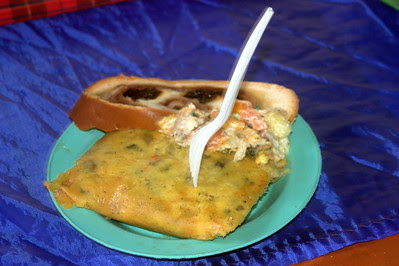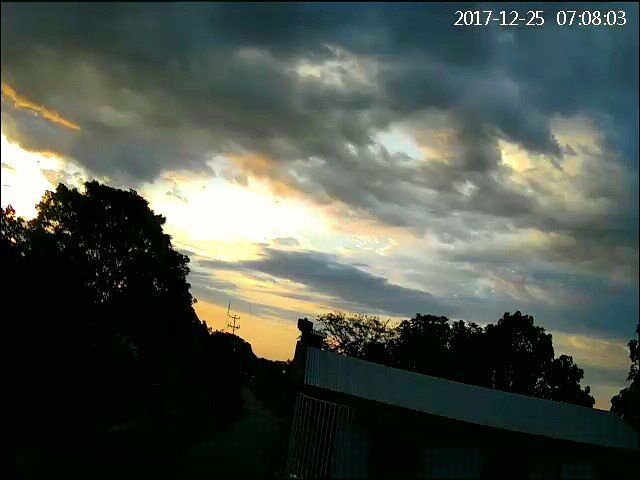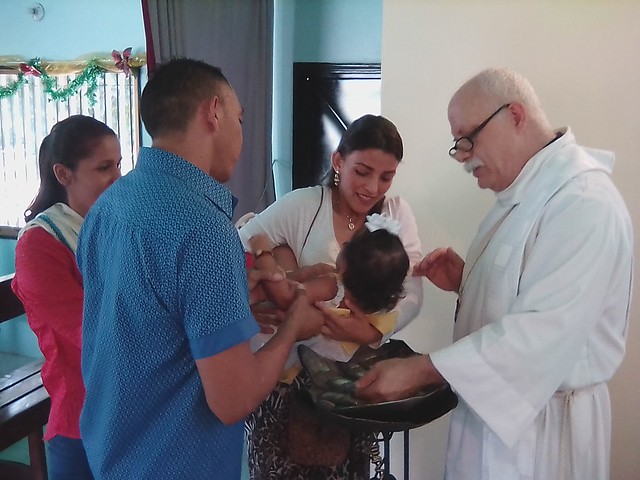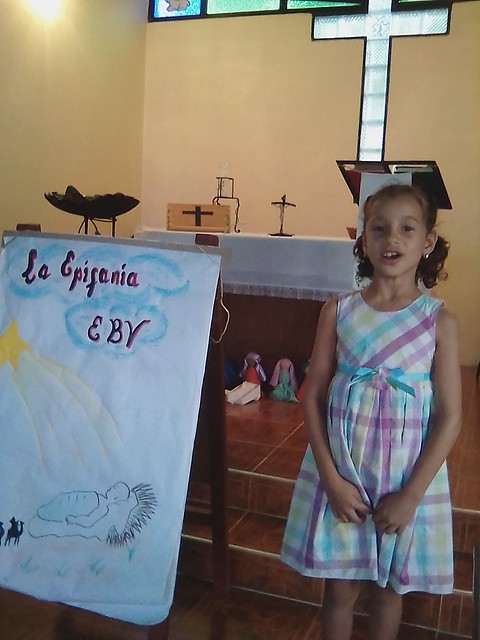
In ancient Greek,
there were at least four words that can be translated into English as
“love” (or into Spanish as “amor”). Rather than one catchall
term for a set of highly nuanced relationships and accompanying
emotions, the Greeks had separate words. The most central to New
Testament teaching is ἀγάπη (agape), which means love which
seeks nothing for itself, only the well-being of the beloved. This is
the love of which St. John speaks when he says, “So we have come to
know and to believe the love that God has for us. God is love, and
whoever abides in love abides in God, and God abides in him” (1
John 4:16). God is agape; He needs nothing from us, yet gave His Son
that we might have eternal life. Agape is most often used describe
this divine love, the character of which is reflected in us when we
show to others this love. “Agape” sometimes is translated as
“charity”, which is a similar concept in Latin, but since charity
to us often means a duty to be done rather than a Holy Spirit-driven
response to God’s grace, it loses something in that translation. I
would refer anyone with further interest to
“The
Four Loves” by C.S. Lewis, an easy-to-read introduction to
agape and the other Greek words for love.
But the plural, ἀγάπαις (agapais) sometimes refers to“love-feasts”,
communal meals served at the place of worship in anticipation of the
Eucharist in the early church. The brethren
were at liberty to eat before going to the meeting; but all
present had to be in a fit condition to receive the Lord’s Supper.
So food was provided for all, even the poorest of the congregation at
the expense of the wealthy. At least, that was how it was supposed to
work. The agape
feasts are mentioned in Jude 1:12, and you may notice the
commentary is not very positive.
“These are
blemishes on your love feasts (ἀγάπαις), as they feast with
you without fear, looking after themselves; waterless clouds, swept
along by winds; fruitless trees in late autumn, twice dead, uprooted;
wild waves of the sea, casting up the foam of their own shame;
wandering stars, for whom the gloom of utter darkness has been
reserved forever.”

St. Paul deals more
directly with abuses of the agape feast in 1 Corinthians 11, verse 17
and following. The consensus of many New Testament scholars is that
the Christians of Corinth gathered in the evening for meetings that
would last for hours and had a common meal in anticipation of the
Lord’s Supper. As the hour for the meal came, the more well-to-do
brought forward hastily their own supper, and sat down with their
family and particular friends. The custom had been for the members to
bring what they could afford for the purpose, the food then being
divided equally among all. But now the poor people had little or
nothing, and therefore went hungry, while the wealthier members ate
and drank to excess, even getting drunk on the wine intended for
communion.
“What! Do you not
have houses to eat and drink in? Or do you despise the church of God
and humiliate those who have nothing? What shall I say to you? Shall
I commend you in this? No, I will not.” Paul says in 1 Corinthians
11:22.
In his Letter 97 to
the EmperorTrajan, Pliny the Younger, a Roman magistrate who
investigated the strange group called Christians, suggests that by
the beginning of the second century A.D., the meal was normally
taken separately from the Eucharistic celebration: he speaks of the
Christians separating after the hour of worship and reassembling
later for a common meal.
Those of us who grew
up with potlucks in the church basement know, thanks be to God, the
tradition of meals at the church for fellowship among the faithful
and for care of the surrounding community was never entirely
abandoned. Even “coffee hour” between the morning service and
Bible class is an echo of the agape feast. For me, something very
close to the agape feast was the pancake breakfast between the Easter
sunrise service and the regular morning service on the Sunday of the
Resurrection.
In the Lutheran
Church of Venezuela, it has long been the practice to invite the
surrounding community to a Christmas dinner. In my
last newsletter, I explained how the traditional Venezuelan
dinner consists of an hallaca, pan de jamón (bread filled with ham
and olives) and chicken salad, and how many Venezuelan families would
not be able to afford the complete package, even if all the
components were available.
One
story has it that one Christmas, the bishop of Caracas asked
faithful Roman Catholics to donate their leftovers to natives and
slaves, and also urged everyone to eat the same as the slaves did, to
avoid huge amounts of food being wasted. They accepted the demand,
and thus began the tradition of eating hallacas on Christmas. The
dish is an icon
of Venezuelan multicultural heritage, as its preparation includes
European ingredients (such as raisins, nuts and olives), indigenous
ingredients (corn meal colored with annatto seeds and onions), and
African ingredients (smoked plantain leaves used for wrapping).
The preparation of
hallacas is in itself a Venezuelan Christmas tradition, as
family
and friends gather to chop and prep the ingredients. Like
Christmas cookies and candy elsewhere, hallacas are not made for only
one household, but as gifts to be shared with neighbors and friends.
So our Christmas
dinner for the mission on December 24 had to include hallacas and
also we managed the chicken salad. Pan de jamón still is hard to
come by. Attending to the material needs of our members and neighbors
through the distribution of food is important, but events like these
also provide companionship and emotional support to people for whom
this holiday is marked by the breakup of families, job loss and
disease. We announced and invited people to our Christmas Eve
service, but we did not publicize the meal afterward. Nevertheless
the chapel was filled to at least the mandated 40 percent of capacity
as the congregation listened to the message of sure hope in Titus
2:11-14.
“For the grace of
God that brings salvation has appeared to all men, teaching us that,
denying ungodliness and worldly lusts, we should live soberly,
righteously, and godly, in this present age; Looking for that blessed
hope, and the glorious appearing of the great God and our Saviour
Jesus Christ; Who gave himself for us, that he might redeem us from
all iniquity, and purify for himself a special people, zealous of
good works.”
What about that
“Christmas Star”?
Well, we didn’t see it
due to overcast nights. But the photography on the social networks
was impressive. Was it the same “star” that shown over Bethlehem?
The idea that the Magi were guided by a conjunction of Jupiter and
Saturn was first proposed by Johannes
Kepler in 1604.
Kepler, as a matter
of fact, was a Lutheran. So Lutheran that he attended seminary with
plans of becoming a pastor. His extraordinary skill in mathematics
made it easier for him to find work as an astronomer instead. As a
man of science, he believed that the “heavens declare the handiwork
of the Lord” (Psalm 19:1) and that the Lord might use natural
phenomena to reveal His will. Kepler
calculated that in the year 7 B.C. there were not one, but three
conjunctions of Jupiter and Saturn: Once in May, again in October and
finally in December. Of course, the theory rests on the assumption
that Jesus was born in December, when the Holy Scriptures do not give
a precise day and month of His birth. Also that He was born in 7
B.C., which may seem odd; Jesus Christ being born before Christ. But
it has long been argued that Jesus was born between 2 and 7 B.C. This
is because, and these are mathematical waters a little deep for me,
there is no Year Zero in the western European calendar system.
Anything that happened either happened B.C. or A.D. Also, there has
been debate about the dates of events used as points of comparison
for the chronology.
But the question
remains, could God have used a natural phenomenon to guide the Magi?
Perhaps. The angel told the shepherds that their sign would be a babe
wrapped in swaddling clothes. There is nothing supernatural about a
babe wrapped in swaddling clothes; the Word of God is what makes it a
sign. In other cases, such as the Virgin Birth or the Resurrection of
Jesus, the overturning of the order of creation is the essence of the
sign.
A gift to get one
moving
Speaking of overcast
skies: Our array of solar panels has done a satisfactory job of
providing emergency power during a blackout of less than six hours.
But what if we had a blackout for a longer period of time (our record
has been three days) and several days of thick cloud cover? Decreased
sunlight increases the amount of time needed for the solar backup
system to recharge.
We received a
Christmas gift to address this problem from Ruth Carpenter of Bryan,
Texas, a longtime supporter of our mission, and Ken Torino, founder
and president of K-TOR®,
LLC , is company based in Clayton, North Carolina, that
specializes in developing and manufacturing human energy-driven
portable power generators. Ken is a former IBM executive and
electrical engineer, with over 30 years of experience.
“I created K-TOR®,
because I saw a need for a personal generator that was small, light,
inexpensive, versatile and easy to use. I have, personally, been
inconvenienced many times by a dead cell phone or flashlight while
traveling or hiking. I have seen news reports of difficulty and
suffering in many parts of the world, due to natural disasters or the
lack of electricity. K-TOR® can provide electricity where there is
none — regardless of the circumstances.”

We warned Ken that
shipping anything to Venezuela would be costly and that there was
great danger of theft once the shipment reached Venezuela. But he
went ahead and sent us a Power Box 50 by DHL Express. But we received
the package in about 10 days and there was only one complication: DHL
assured Ken that they could delivered it right to our door, which I
doubted would happen. Sure enough, when the package arrived in
Barquisimeto (three hours drive north of Barinas), we were told that
we would have to pick it up there. Thanks to Pastor Eliezer Montoya,
Nancy and Anny Mora of Cristo es Amor Lutheran Church in
Barquisimeto, the package was picked up and reshipped to Barinas.
The true Festival
of Lights
Although there is no
historical connection, the progressive lighting of Advent wreath
candles bears some resemblance to the lighting of one of the branches
of the menorah on each night of Hanukkah. The Jewish festival is
celebrated for eight days between the end of November and the
beginning of December.
Hanukkah
commemorates the rededication of the Second Temple of Jerusalem, that
is, the temple built after the captivity in Babylon, and the
successful rebellion of the Maccabees against Antiochus IV Epiphanes,
a Greco-Syrian dictator, about 200 years before Christ, We find this
story in the deuterocanonical books of I and II Maccabees, which are
found in the Septuagint, the version of the Old Testament translated
into Greek before Christ, but not in the original Hebrew canon
inspired by the Holy Spirit.
Antiochus desecrated
the Temple in Jerusalem with idols and pig sacrifices. Jewish
tradition speaks of a miracle, in which the menorah or candelabra of
the Temple was lit for eight consecutive days with a meager amount of
oil, which was enough for only one day, for the purification and
consecration of the temple again. For this reason, Hanukkah is called
the Festival of Lights or Luminaries.
It is also known as
the Feast of the Rededication and that is what is mentioned in the
Gospel of John, chapter 10, verse 22. The text says that Jesus and
His disciples walked in the Temple during this feast. On that
occasion, He answered the question whether He was the Christ, or the
Messiah promised to the Jews in the Old Testament. However, the Jews
expected a messiah like Judas Maccabeus, a military and political
chieftain who came to establish his kingdom by means of the sword.
Jesus was the true Messiah who came to suffer on the cross and
overcome the power of sin, death and the devil. Then, to answer,
Jesus referred to his works that fulfilled the messianic prophecies
of the Old Testament.
Furthermore, he told
them, "I and the Father are one." The meaning of this
statement is that Jesus and the Father are, with the Holy Spirit,
three persons in one divine essence.
Then, in the book of
Revelation, St. John saw the risen Christ among seven golden
candlesticks, which Jesus told him symbolized the seven churches in
Asia Minor that Jesus commanded John to dedicate his book. But, the
book of Revelation is also for the whole church until the second
coming of Christ. Therefore, the seven candlesticks mean that Christ
is present in the heavenly Jerusalem temple, also in every church
where the Word of God is preached in its purity and the sacraments
are administered according to the Lord's command. Hanukkah celebrates
the independence of the Jews until the conquest by the Romans. In our
feast of lights, that is, the lights of the choir of angels and the
star of Bethlehem, we celebrate the eternal victory of Jesus Christ.
Fast forward with
Zoom
This month Luz Maria
wrapped up her work with mentoring deaconess students in a course on
Luke’s Gospel and the Book of Acts, delivered by a series of Zoom
videoconferences with instructors from Concordia
El Reformador Seminary in the Dominican Republic. On December 13,
the third Sunday of Advent, we had a successful videoconference with
Pastor Bruce Keseman’s adult Bible class at Christ Our Savior
Lutheran Church in Freeburg, Illinois (this is my mother’s
congregation). If anyone else would like a presentation about our
mission via Zoom, talk to us about scheduling.




























![Reblog this post [with Zemanta]](http://img.zemanta.com/reblog_e.png?x-id=150ac9e3-5190-4c37-8337-6e4564b64b15)